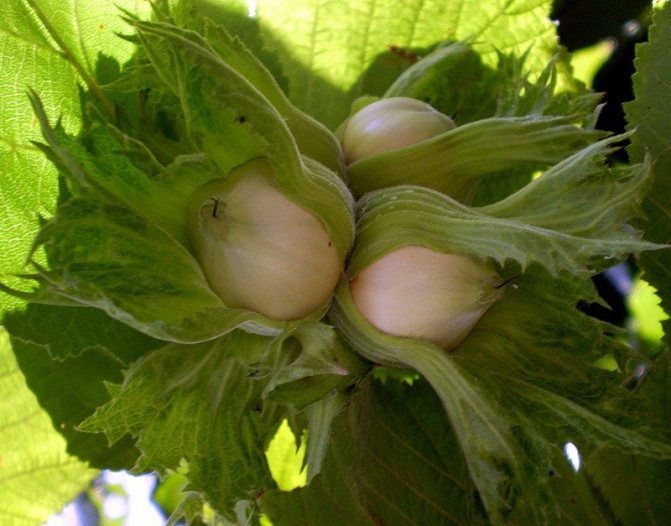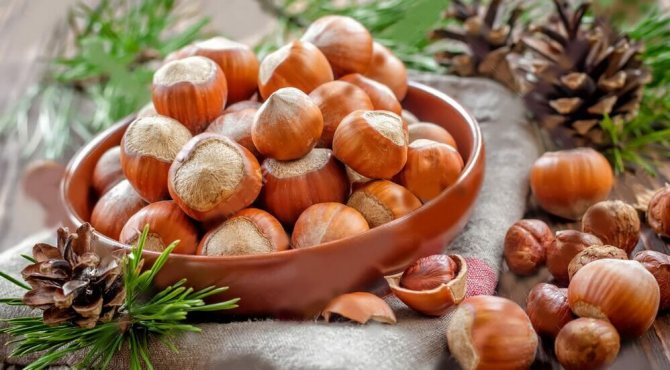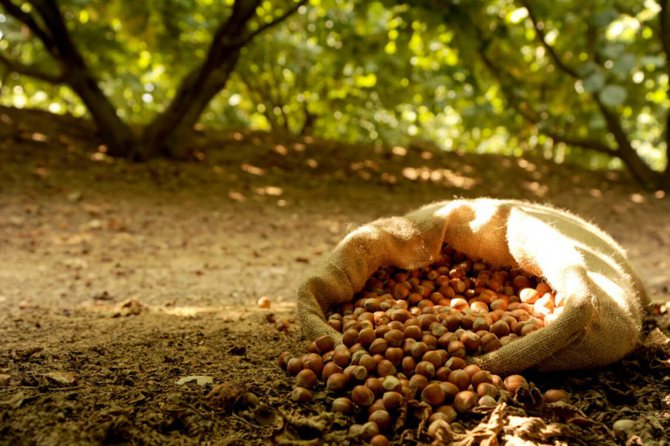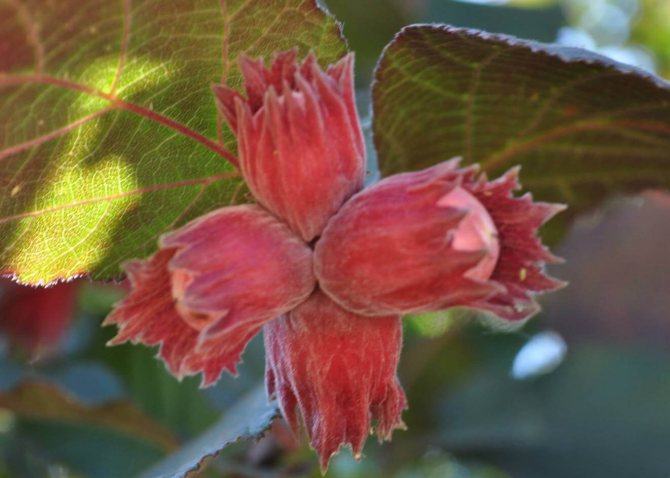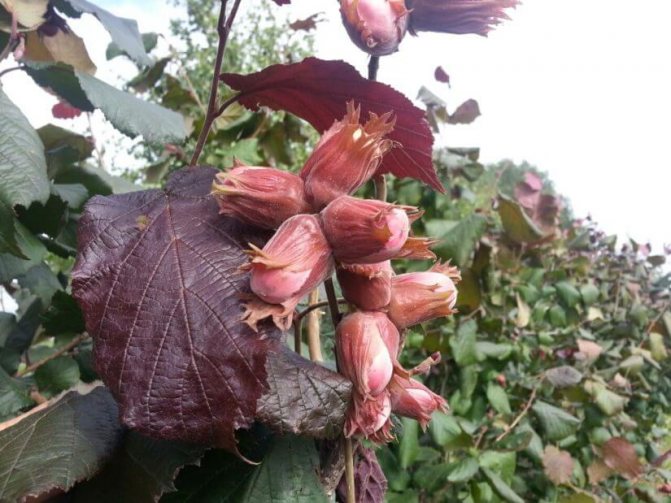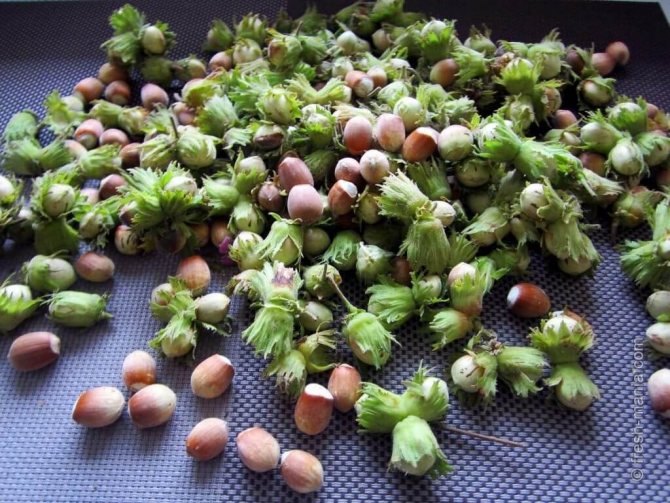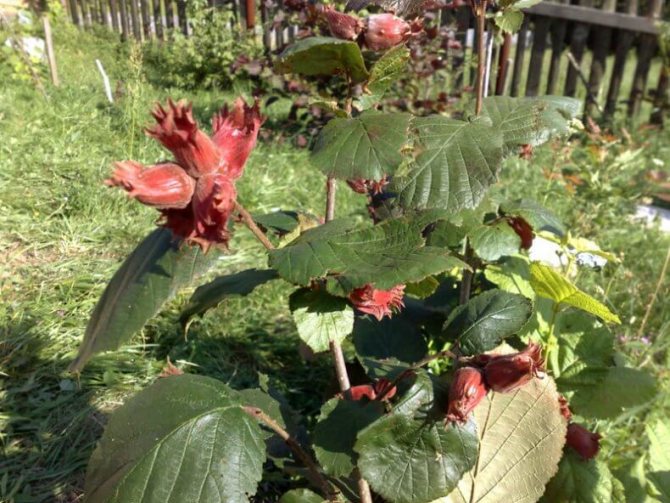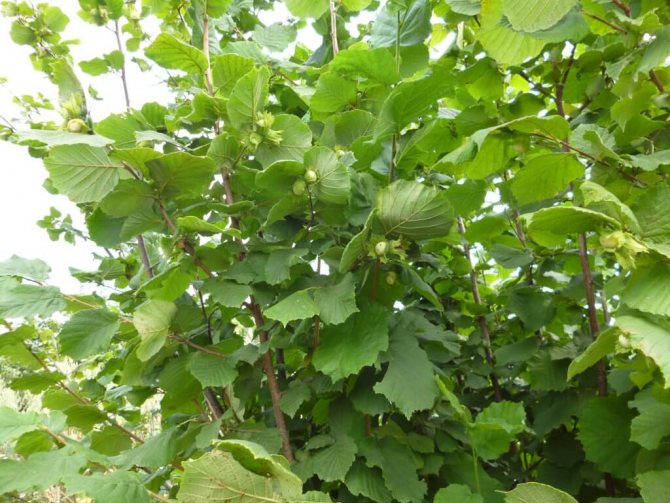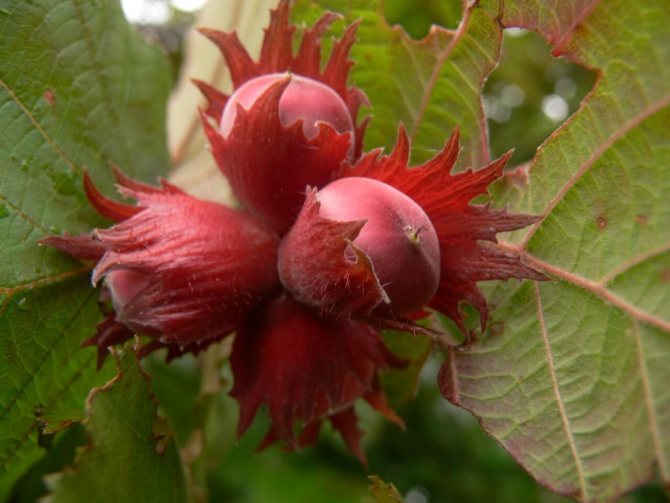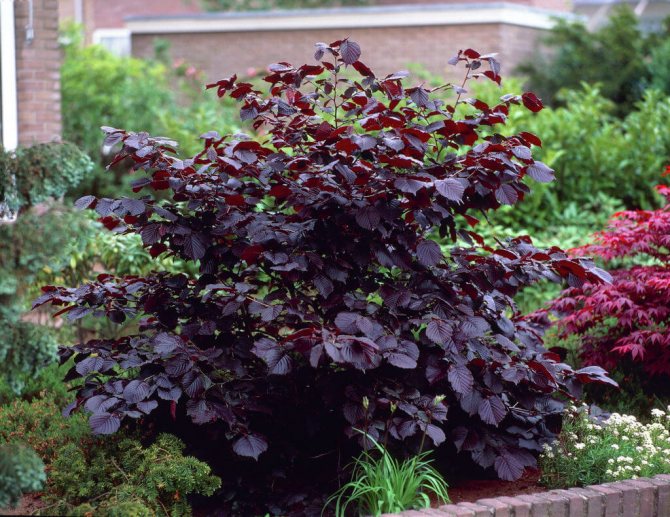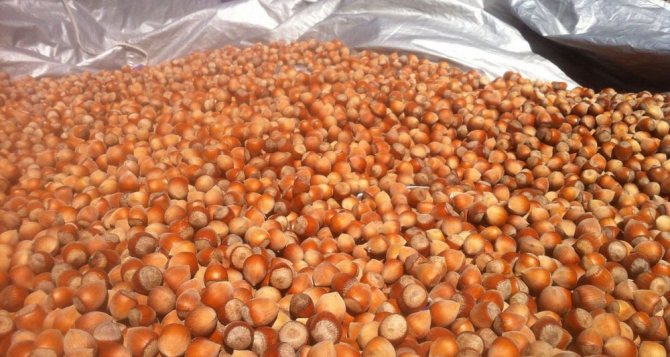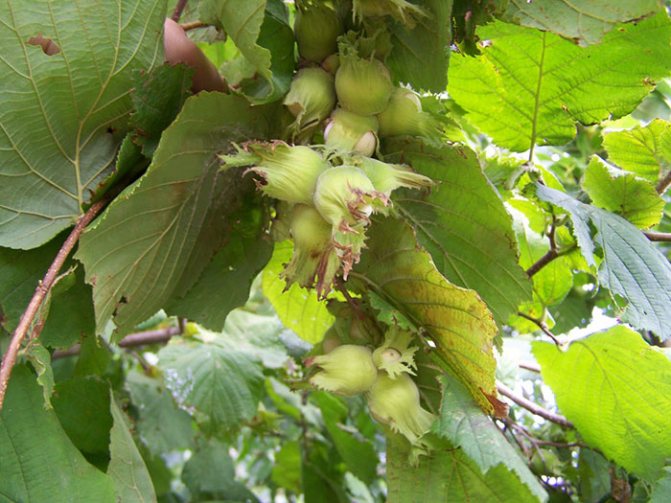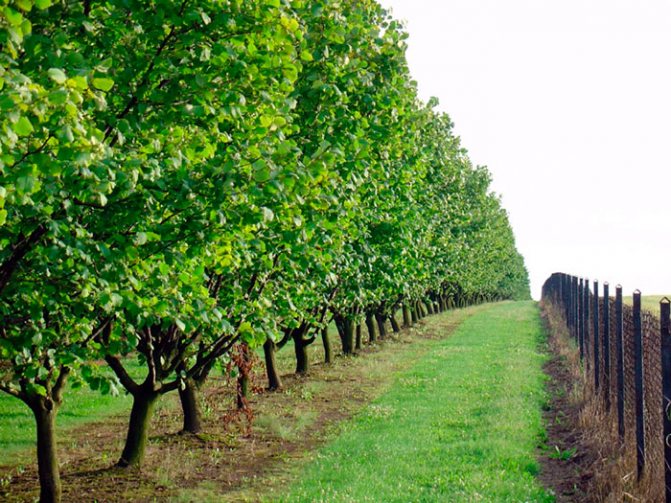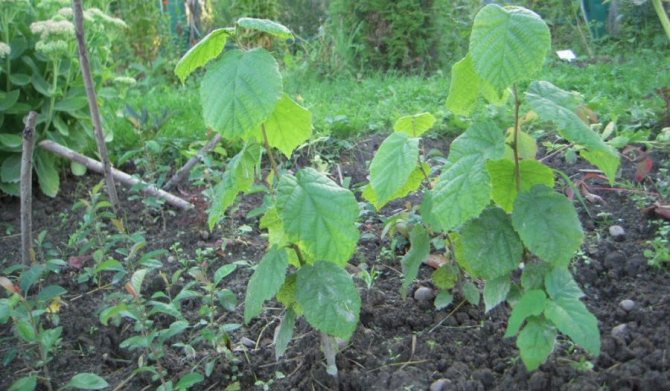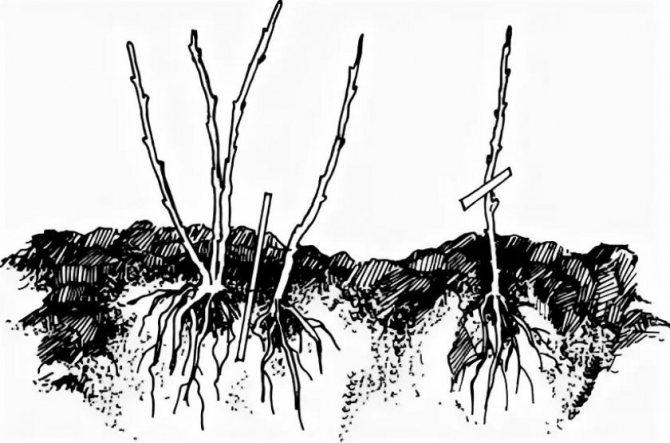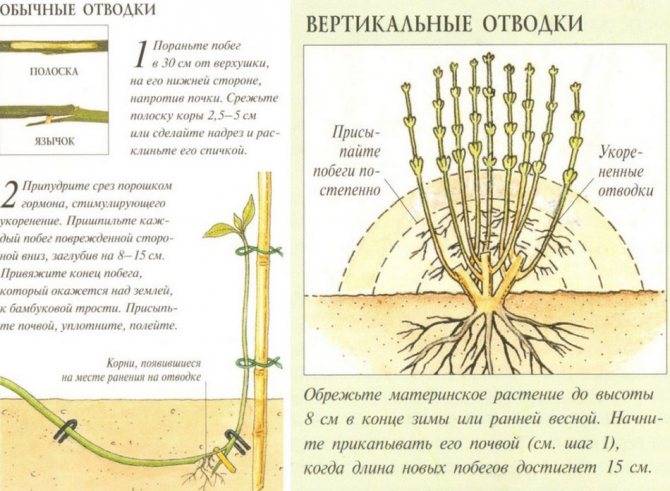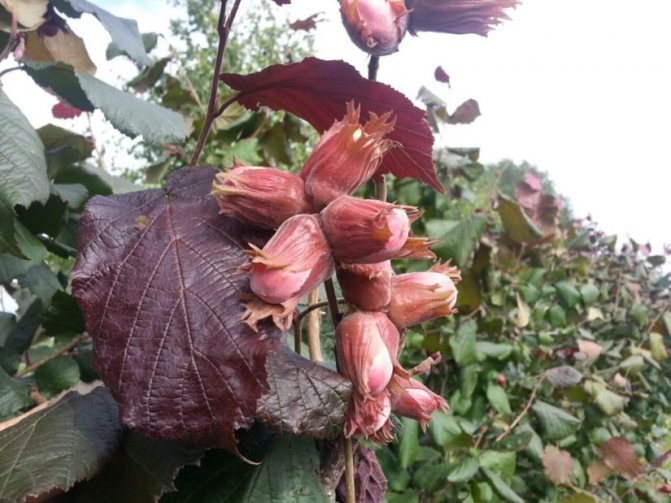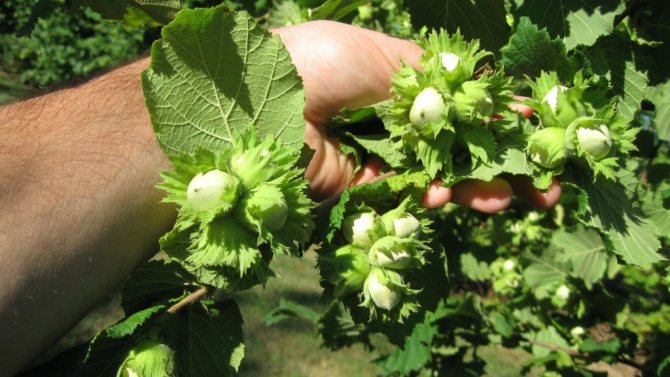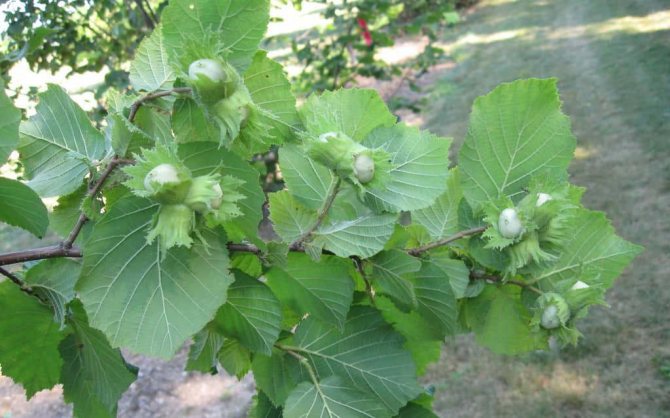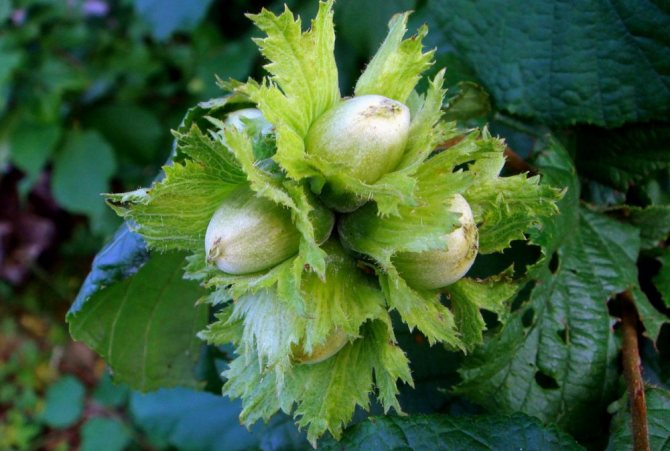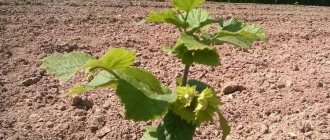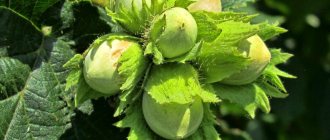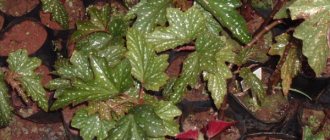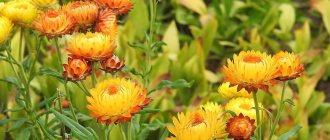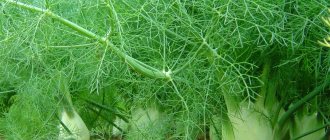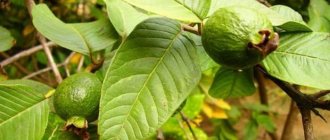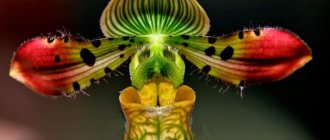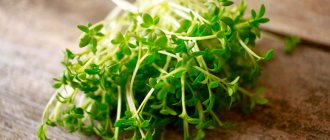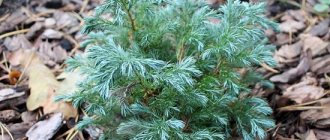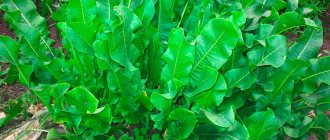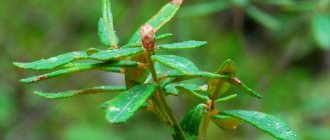When my grandfather was alive, we spent every Saturday with him, as the parents worked that day. We often walked together with the forest. Far from home we had our own hazel bush, and for a whole year I waited patiently for these delicious nuts to ripen. So I wanted to pick up a lot, a lot - for myself, grandmother, parents! But something always got in the way - sometimes other young "treasure seekers", then nimble squirrels robbed us. Now my grandfather is gone, and in memory of him I planted the best varietal hazel in the yard. And now my dad and his grandchildren (my children) are picking ripe nuts from the bushes.
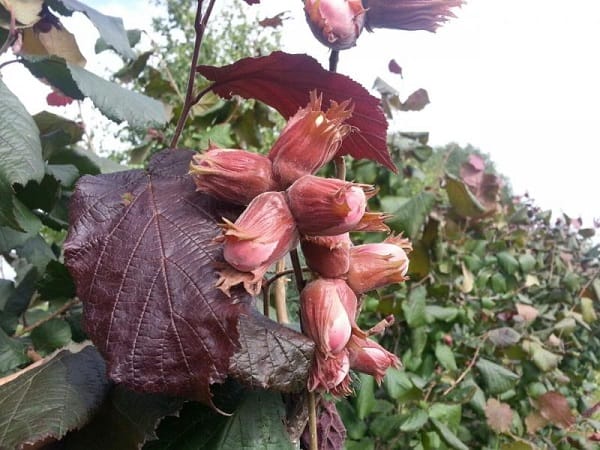
Red-leaved hazel: what is it?
So, red-leaved hazel is a rather powerful, well-branched, multi-stemmed shrub plant, reaching a height of seven meters. The main feature of the plant is the presence of beautiful rounded leaves, with well-visible serrated edges and pronounced venation, which change their color depending on age. The leaves bloom on short, dense petioles and very densely cover the branched branches of the bush, hiding their presence under their huge mass.
At first, in early spring, earrings bloom on the branches - the future nut fruits. So the hazel blooms. Bare branches cover male flowers in the form of earrings and female ones, which in appearance resemble swollen buds, releasing small lilac flowers. It is the female flowers that are pollinated by moving air masses and thanks to the help of bees that woke up after hibernation.
Hazel is red-leaved, for all its advantages, it is also a melliferous plant. Therefore, small flowers attract hardworking insects with their nectar, feeding and transferring pollen from one plant to another, thus pollinating it. After pollination, female inflorescences form fruits, which can be found on branches, either singly or in whole fruit inflorescences of three to five pieces.
After blooming, bright green leaves appear, which eventually turn purple in color. And already by the time the fruits ripen, which falls on the end of August or the beginning of September, the hazel shrub becomes like a huge burgundy ball, on the branches of which there are dark brown fruits. It is this color of the nut that speaks of its ripeness and the possibility of starting harvesting. The ripeness of the fruit is also evidenced by the easy hulling of the nut from the seed. Having found several walnut fruits under the bush that have fallen out on their own, you can start harvesting. One adult red-leaved hazel shrub is capable of producing, with proper care, about 20 kilograms of such valuable products.
True, the amount of the harvest does not always please the owner, there is no year after year, and in one season there are a lot of nuts, in the other - negligible. It all depends not only on the weather conditions, but also on the proper care of the shrub plant.
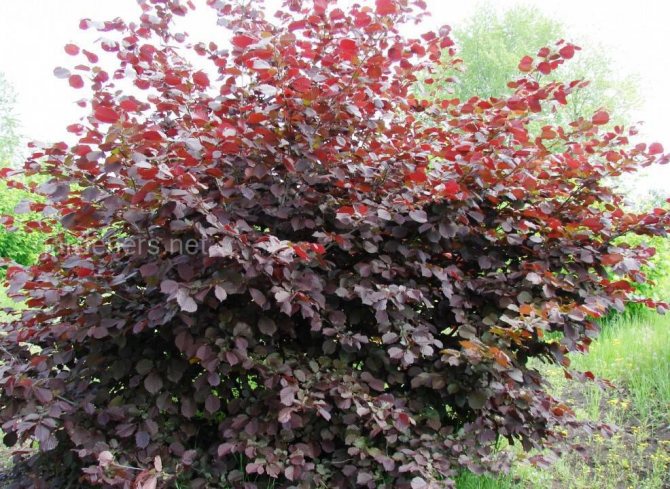

Description and features
This type of hazelnut has unusual red leaves. The plant is considered quite unpretentious and can grow in any soil. The bushes have a spreading crown, large branches and dense burgundy leaves. Therefore, this type of hazel is often used for decorative purposes. You can make a beautiful hedge out of it.
The plant is considered bisexual.Earrings appear on it in early spring - even before the leaves bloom. Subsequently, fruit ovaries are formed from them. They turn dark brown in August-September.
From a bush, you can get up to 20 kilograms of fruit. They have excellent nutritional properties. Kernels of nuts help to treat pathologies of the respiratory system, heart and blood vessels. The plant is unpretentious to care for. It easily tolerates heat and cold.
Planting technology for hazel bushes
In their natural environment, growing in forest spaces, hazel shrubs do not grow alone. Usually there are so-called thickets, that is, under the ground, the roots of a tree plant grow and, with high humidity, start up new shoots. Thus, the red-leaved hazel grows and not one plant, but several in a row grows like a family, and, as a result, crosswise, with the help of the wind, pollinates each other. It is the presence of several bushes growing side by side that increases the pollination of female flowers and gives a higher yield of fruits. In home gardening, breeders also recommend observing this feature and growing more than one hazel bush, but planting several at once. You can plant different varieties of hazel along the fence. The yield will still be much higher than that of a lonely growing shrub.
Planting seedlings should be done in early spring or late autumn. Young seedlings obtained from the main bush are cut to 35 centimeters in height, and before planting, the roots are placed for a couple of hours in a slurry of humus and clay, highly diluted with water. Gardeners recommend doing this procedure, considering that after this manipulation, the plant takes root much better in a permanent place of growth.
Seedlings are planted in a row, at a distance of 5 meters between the bushes, because the plant is very branched and requires space. Young seedlings are tied to wooden supports to avoid mechanical damage. Before planting the prepared bushes, they dig holes of a rather large size, for the possibility of introducing various soil mixtures. A large bucket of rotted humus is first poured into a hole measuring 70 by 70 centimeters, 300 g of potassium salt, 200 g of superphosphate and half a bucket of garden soil dug out from under an already growing hazel bush are added. On the root system of an already adult and fruiting shrub, mycoses are formed, which are compounds of fungi and roots. Such an additive to the soil mixture will allow the young seedling to take root faster, build up the root system and develop well.
Reproduction methods
Hazel can be propagated in different ways. This allows each gardener to choose the best option.
Seeds
The use of seed is considered the most difficult and time-consuming method of propagation. To do this, you need to choose the strongest nuts and germinate them in a separate container. Then the seedlings should be transferred to the ground.
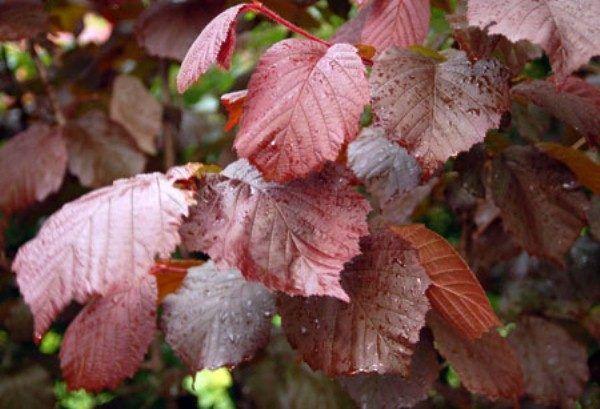

Root layers
For cultivation of culture by layering, young shoots are used. It is recommended to incline the layers to the soil and place them in a ditch. The end of the branch should be fixed and sprinkled with soil. This will help form new scions.
Shoots
The easiest way to propagate a culture is to divide the bush. To do this, you need to separate the plant containing 2-3 shoots. Make small cuts at a distance of 15-20 centimeters. This will help form new branches.
Cuttings
To do this, you need to take strong and healthy cuttings from bushes 2 years old and place them in containers based on peat and sand. Constant watering will help the shoots take root.
Secrets of proper care for red-leaved hazel
It should be noted that not only adherence to planting technology, but also proper care will give an excellent result, in the form of a powerful plant and a rich harvest.
- Optimal potting mix.Considering that shrub hazel grows in its natural environment in forests on any soil, then there are no special requirements for the soil. Loam, sandy loam, black soil in the garden is an excellent soil for a walnut tree. And if there is also high-quality moisture and periodic fertilization, we get excellent productivity.
- Convenient location is the key to success.It is not always possible to find a free space in the garden for such a large plant, and even if there are several of these plants. Usually shaded areas remain free from planting vegetables. Of course, on sunny beds, the yield will be much higher than on bushes growing in the shade. But, the plant is distinguished by its shade tolerance, and if it is not possible to plant it in the sun, plant it in the shade. Maybe over time, the shrub will grow and compete with a number of growing bushes for a place in the sun.
- Frost resistance and ability to adapt to cold weather.The shrub is quite strong and tolerates low temperatures well, but if possible, cover young seedlings for the winter to avoid freezing of the root system. In addition, for planting, choose places where there are no drafts.
- Basic rules for soil moistening.Red-leaved hazel is a drought-resistant plant, and sprouting in the forest belt, it itself seeks moisture for its roots. When growing a shrub in the garden, watering is carried out as the earthen coma dries up in the hole. Water the plant in the morning or evening with warm water. Remember, the plant does not tolerate stagnant water, so it is better to water more often than pour too much at once.
- Fertilizing the soil is a component of a rich harvest.Organic matter is needed, both for young shrubs and fruit-bearing ones. Organic fertilizers are applied at intervals of once every three to four years, but minerals are needed for the shrub every year. The introduction of urea during the flowering period of a shrub tree will increase the number of ovaries, so feel free to use nitrogen-containing complexes at the first appearance of buds for flowering. After the end of flowering, it is strictly forbidden to use nitrogen, since the formation of high-quality fruits will fade into the background, since nitrogen is responsible for the lush green mass. Phosphorus and potassium should be the prerogative during the formation of the hazelnut fruit.
- Loosening is a necessary and important procedure.After watering and almost complete drying of the top layer of soil in the hole, loosening is performed. This process helps in the fight against weeds, increases air access to the roots, and favors the growth and development of the root system.
- Crown formation is an essential task when growing a shrub.Any shrub needs pruning of old branches and removal of affected areas. Red-leaved hazel is considered a tree-like shrub, therefore, if you want to form a bush like a tree, you can leave a trunk with branched skeletal branches from the main stem. And you can grow a plant with a shrub. Then you need to cut out the branches leading to thickening, cut off old or dried shoots, leaving, nevertheless, up to 7-8 central trunks, branching evenly from the root, and not grouped on one side. The length of the branches or the height of the tree is also regulated at the request of the owner. You can leave long skeletal branches, or you can shorten them, then they will release more side shoots, on which full and abundant flowering will come next season.
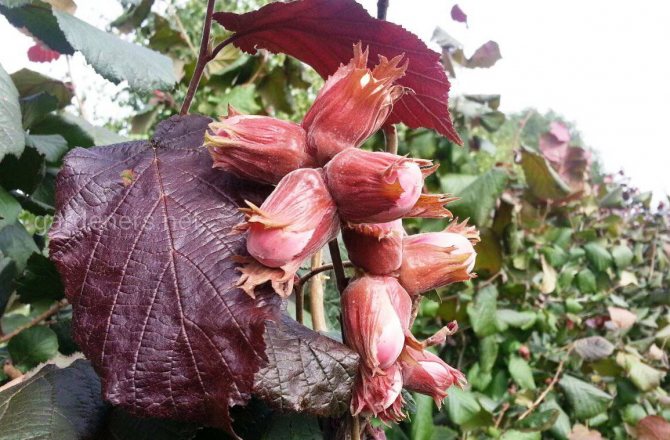

The benefits of hazelnuts
Hazelnuts are tasty, healthy, nutritious. They contain 65-73% fats (oils), 18-22% proteins, 2-5% carbohydrates (starch and sugars). There are vitamins A, B, C, D, E, mineral salts. This determines its high calorie content as a food product. In terms of calorie content, hazelnut kernels surpass pork by 1.5 times, soybeans - 1.8 times, wheat bread - 3.5 times, beef - 3.8 times, chicken eggs - 4.5 times, potatoes - 8.5 times, apples - 15 times.For reference: 350-400 g of nuts satisfy the daily nutritional requirement of an adult.
The hazelnut kernel contains all twenty amino acids, from which complete proteins are formed. It retains its taste during storage even under normal room conditions. Nuts are easily absorbed by our body, no matter how they are cooked. This is an unsurpassed high quality product.
Hazelnuts have a lot of vitamin C in the roots and plyus of hazelnuts. Leaves and roots contain tannins.
In folk medicine, hazelnuts (hazelnuts) are used for urolithiasis, a decoction of dried plyusa - for diarrhea, bark - against fever, leaves - as an antiseptic.
Walnut, pounded with water, is used for coughing up blood, flatulence, bronchitis, and fever.
Chopped walnut mixed with honey is recommended for anemia, rheumatism.
A decoction of hazelnut bark, collected in spring, is used for malaria.
Walnut oil is an antihelminthic agent (for ascaris).
Crushed fruits mixed with egg white were used for burns.
Not only hazelnuts are useful. The bark has astringent, anti-dysentery, antipyretic properties. Bark infusions are used for varicose veins, varicose ulcers, and tumors.
Hazelnut leaves (hazel) are used to treat intestinal diseases, anemia, vitamin deficiency, rickets. Broth - with prostate hypertrophy. Ointment for cancer. Powder from dried plyusky or decoction of shells and plyusky - for colitis.
In early spring, beekeepers often harvest hazelnut or hazel pollen to feed young bees. This pollen is very useful for people: these herbal male genital products contain a lot of zinc, which is part of many enzymes that help solve the problem of infertility, making sperm motile.
Protection against fungal infections
As you know, any tree or shrub in the garden is susceptible to infection with viral and fungal diseases, the spores of which easily winter in the garden soil. Spring and autumn treatments with solutions of Bordeaux liquid or colloidal sulfur will serve as a high-quality prevention of common diseases. And if signs of specific diseases are identified, then chemicals offered in specialized stores will come to the rescue, which should be used exclusively with reference to the instructions specified by the manufacturer.
Hazelnut processing
The nuts are harvested when they begin to crumble. They clean them of plush, store them in tight bags
The plyuska is also dried. You can cook jam from a green young plyuska, it has a pleasant sourness, syrups that help in the treatment of scurvy, loosening of the gums, impaired blood circulation, with increased pressure.
Hazelnuts are eaten raw, dried or roasted. From them you can make nut milk... To do this, fresh kernels are cleaned, crushed, soaked overnight in water, ground in a mortar. The resulting mass is diluted with a nine-fold amount of water, insisted for 4 hours, stirring from time to time. Then they boil, filter or drain the liquid part, adding salt and sugar to taste. By the way, nut milk turns sour and gives a delicious yogurt.
For getting nut butter crushed hazelnut kernels, slightly diluted with water, heated. The heated mass is wrapped in a piece of clean cloth, placed under a screw press, under which a vessel is placed to collect oil. It is not inferior in quality to almond, it is used in perfumery, confectionery, in the manufacture of high-quality artistic paints. Walnut oil has a light yellow color, a pleasant smell, and is well absorbed by the human body. The dough with the addition of nut butter rises well, and the finished products do not stale for a long time.
Hazelnut kernels are often used to obtain vegetable cream, milk, and other products. To prepare nut cream, the kernels are peeled from shells, peels, crushed, ground, gradually adding water in small portions. The doughy mass is diluted with warm water, whipped until a homogeneous mass is formed, reminiscent of cream in taste. Store hazelnut cream in the refrigerator. Hazelnut cream is used in its natural form, a delicious, nutritious cream for pastries, muffins, cakes is prepared from them.
Young leaves of hazelnuts are used as food for making stuffed cabbage rolls, soups and as a surrogate for tea.
The calorie content of a nut is much higher than that of beans, soybeans, raisins, figs, milk, and potatoes. Hazelnuts are widely used in the confectionery industry. Fillings for sweets and other confectionery products are made from nut flour and kernels. The cake remaining after the separation of the oil is processed for halva, chocolate, waffles.
Insect pest protection
Drilling beetle, nut weevil, scale insects, aphids, kidney mites, caterpillars - this is not a complete list of pests that can damage both the plant itself and the fruits at different periods of their ripening. Of course, insecticide solutions are an effective aid in the fight against insects, so the main thing is to find and neutralize uninvited guests in time, as well as to prevent attempts at repeated defeat. For such purposes, in spring and autumn, it is advisable to carry out preventive treatment of shrubs, then the likelihood of pests appearing during the active growing season of the plant is minimal.
Culinary recipes
Finally, a few recipes.
Nut cream for cake
Beat eggs and sugar until thick in a saucepan placed in a water bath, then cool, add pieces of butter, nut cream, grind thoroughly
Ingredients:
- eggs - 3 pcs.,
- butter - 150 g;
- sugar - 150 g;
- nut cream - 100 g.
Nut drink
Pour the soaked, chopped nuts with water or milk for 4 hours, then strain. Bring the infusion to a boil, add salt and sugar to taste.
Ingredients:
- hazelnuts - 200 g;
- milk or water - 1 liter;
- sugar, salt - to taste.
Nut coffee
Fry hazelnuts, grind with a coffee grinder or mortar, add ground black coffee. Brew one teaspoon of the mixture with 200 ml of boiling water, bring to a boil, let stand and infuse. Add sugar to taste.
The use of red-leaved hazel in landscape design
Red-leaved hazel is very beautiful with its powerful branches, spreading shape and purple deciduous mass. Thanks to its external beauty, the plant has found wide application in landscape design. Monochromatic or monochrome gardens are beautiful, but they also try to decorate them with various plants with a different color scheme. Playing with color shades is an interesting way of manifesting the creative imagination of the owner of the infield. Blooming buds undoubtedly add variety to the overall flavor, but burgundy leaves, and even in large numbers, are part of the landscape gardening art. Plants with purple leaves, as separate elements that are bright spots against the general background of the garden plot, will undoubtedly attract attention and make passers-by admire the beauty. And if you surround the red-leaved plantations with greenery on all sides, then the site will look very impressive and elegant. The combination of a burgundy shade with bright green looks very harmonious, and if you add a few more light shades, then the beauty of the site's appearance will only increase. Landscape design specialists assure that the bright green color of the garden plantings diluted with the purple color of the red-leaved hazel deciduous mass will undoubtedly decorate the garden.
Each owner sees the garden in his own way, decorates and ennobles in accordance with his taste and preferences.The main thing is that the appearance and the work done would bring pleasure and delight the soul.
Hazelnuts are useful for healing
And here are some popular recipes.
Jaundice
Dry fresh leaves of hazelnuts or hazel. Pour one teaspoon of leaves crushed to a powdery state with a glass of white wine, leave overnight. Divided into three portions, taken daily before meals in three divided doses. After two weeks, the jaundice disappears.
Varicose veins
- Collect hazelnut leaves in May. Pour 0.5 liters of boiling water over two tablespoons of leaves, leave for 2 hours. Drink half a glass 4 times a day before meals.
- Pour 0.5 liters of boiling water over one tablespoon of chopped hazelnut bark, cook for 10 minutes, drain. Drink half a glass 4 times a day before meals.
Adenoma
Dry the hazelnut leaves collected in June in the shade. Pour one tablespoon of chopped leaves with a glass of boiling water. Heat in a water bath for 15 minutes. Drink 1/3 cup a day.
Trebizond
Hazelnut Trebizond has such a description of the variety.
This is a high-yielding variety of hazelnuts bred in Georgia. Rounded graceful walnut with a shiny dark brown shell, containing up to 72% fat, weighing up to 3 g; in seedlings of 3-6 nuts, which ripen at the end of August and are distinguished by excellent taste. A vigorous, spreading bush reaches a height of 5 m, blooms from February to April. Can withstand frost down to -32 ° C.
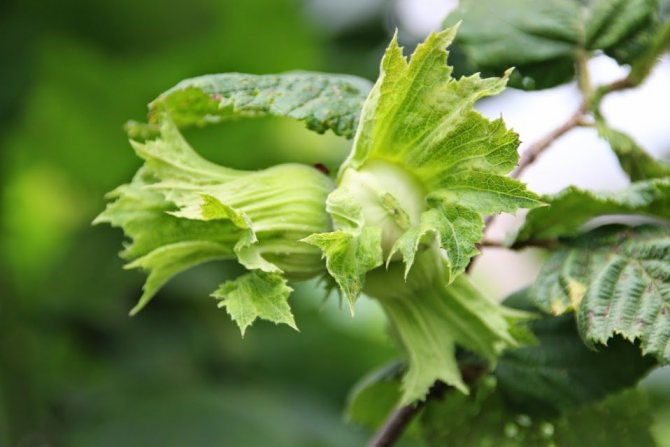

Isaevsky
The variety was obtained by Kudasheva by crossing the Tambov early hazelnuts with the Akademik Yablokov variety.
This variety has large, light-brown fruits with dark brown stripes, distinguished by a wonderful dessert taste. The walnut has exceptional frost resistance. It is known that even the harsh Moscow winter of 1978, when the temperature dropped to -42 ° C, did not affect the fruiting of the Isaevsky hybrid, while it turned out to be fatal for apple plantations.
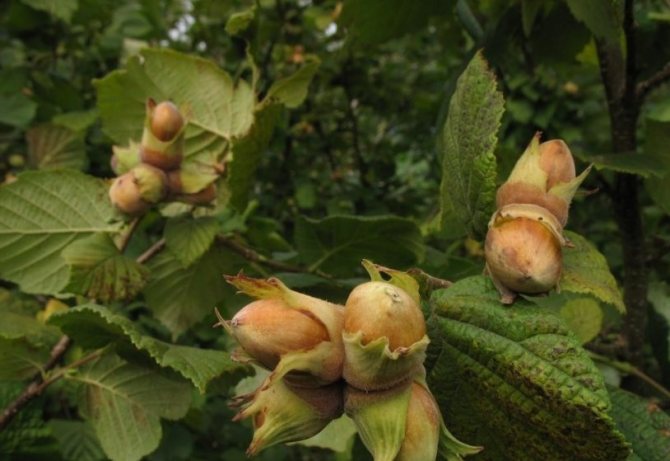

Sugar
The Sakharny hazelnut variety has the following description: a red-leaved hybrid variety, bred by crossing the Barcelona variety and Trebizond hazelnuts, in the state register since 1995.
Ripens in early September, has good winter hardiness. Male catkins are a good pollinator for other varieties; for pollination, the Sakharny variety uses the large green-leaved varieties of hazelnuts Tambovsky Early and Pervenets. Medium bush - up to 3.5 m, forms a dense spreading crown.
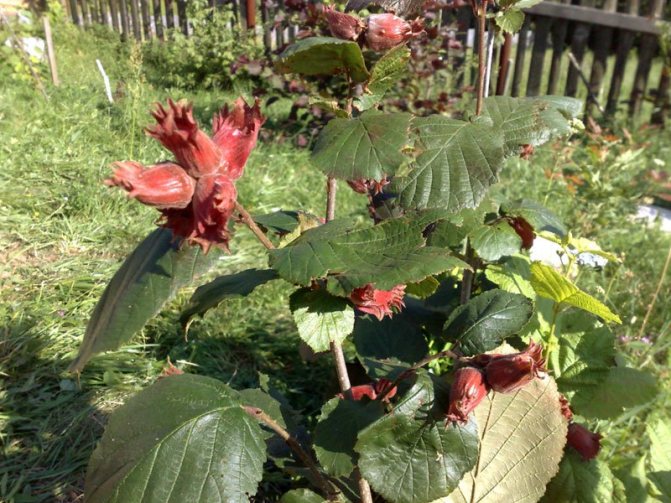

Round nuts with a thin shell weighing 1.8 g, kernel yield - 48%, dessert taste, delicate, buttery - 71%, yield - 3 kg per bush. The wrapper is equal to the nut. The variety has a high decorative effect - leaves and nuts of dark cherry color. Among the advantages of the variety is high frost resistance.
Did you know? This variety contains more oil and sugar than all other hazelnut varieties.
Barcelona
A vigorous bush with a dense spreading crown, reaching a height of up to 5 m.
Large elliptical or rounded light green, fleecy leaves with serrated tips and small denticles at the edges. The nut wrapper is 2 times longer than the fruit and is widely spaced. During ripening, the shell opens, allowing the nuts to fall out freely.
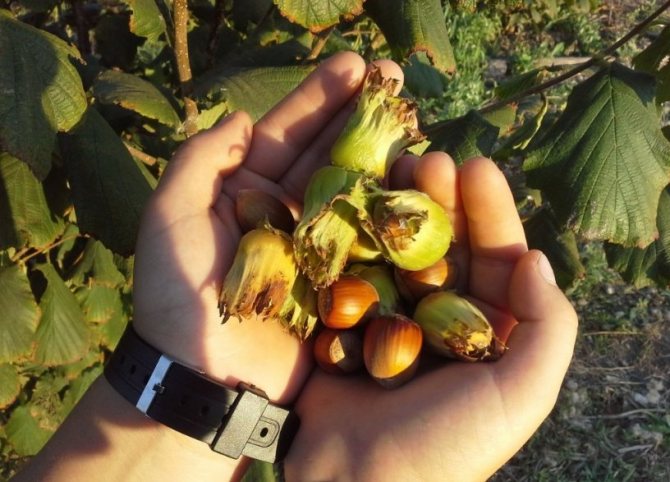

Nuts are very large, ovoid or cone-shaped, slightly flattened and often triangular, with a conical base, with a spiny apex, their width is up to 2 cm; with a thick brown-red shell and an asymmetrical juicy sweet kernel. Variety Barcelona is very prolific, nuts ripen in early September. Disadvantage of the variety: vulnerability to moniliosis.
The best pollinators for him are high-yield varieties of hazelnuts Galle, Lambert white.
Important! Hazelnuts are higher in calories than meat and fish, so people suffering from excess cholesterol in the body and overweight are undesirable to eat it.
How to choose the right variety
You need to choose a variety of hazelnuts based on the growing region. When choosing a variety, first of all, you need to pay attention to the frost resistance of the tree and to the climatic conditions. Heat-loving varieties will not be able to adapt to the climate of most regions of Russia.
Several trees with male and female flowering should be planted nearby.
For pollination to be successful, you need to plant next to varieties with the same period of blooming of inflorescences.
Adyghe
A seedling obtained as a result of free pollination of a local form by N.A.Tkhagushev at the Kuban State Agrarian University.
A mid-season variety, it is highly frost-resistant, easily tolerates drought, and is not susceptible to damage by diseases and pests. A bush with a medium-dense crown and pubescent, yellow-olive shoots. Widely round fruits, collected in 4-5 pieces, whole wrapper longer than a nut, hazelnut taste - sweet, tart, fat content 65.6%, kernel yield - 49%. Included in the state register in 1973, has been on trial since 1967.
There is also a hazelnut of the Adyghe folk selection - the Circassian variety.
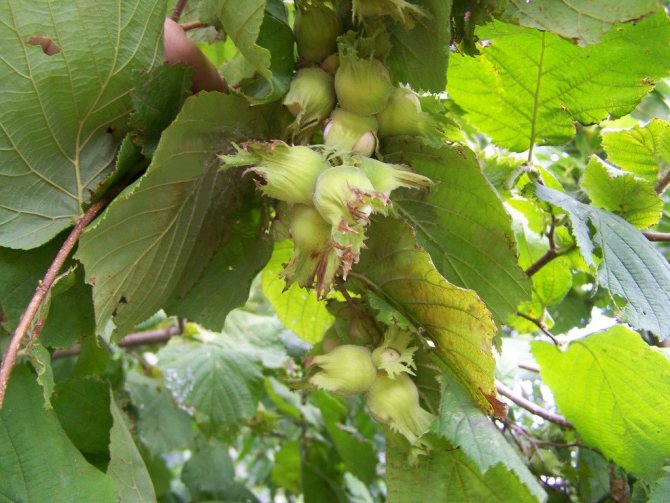

Lambert white
Medium-sized, slow-growing shrub, with elongated medium-sized ovoid nuts, collected in clusters of 3-8 fruits.
The base is small and light. The high-quality kernel completely fills the shell, with very high palatability, light-skinned and without a fibrous sheath. Light shells with darker stripes are thin and brittle. The fruit wrap is very long and fits snugly against the nut. The variety ripens early: in late August - early September.
The variety is frost-resistant and high-yielding, like all hazelnut varieties grown in the North Caucasus.
